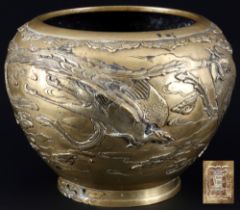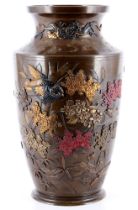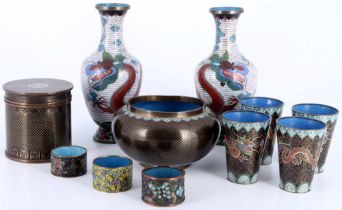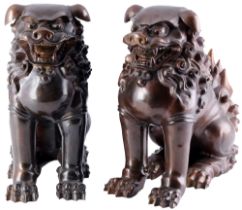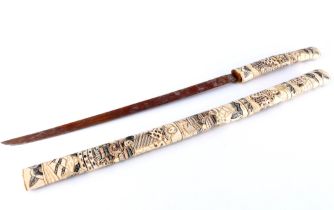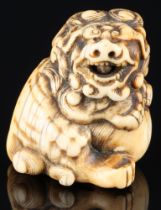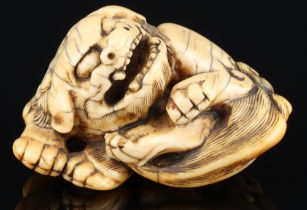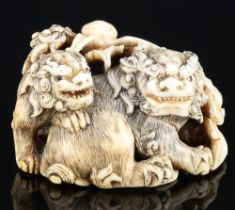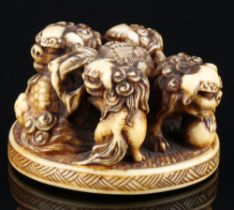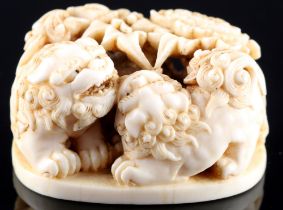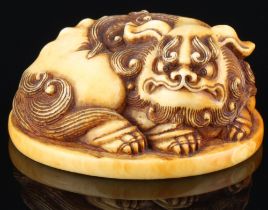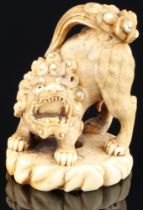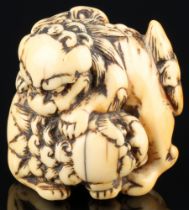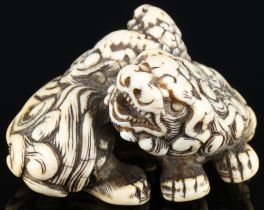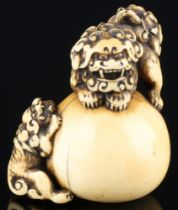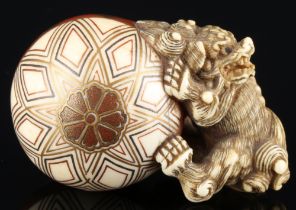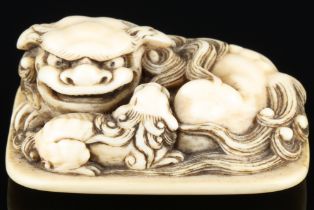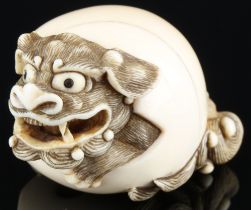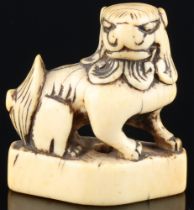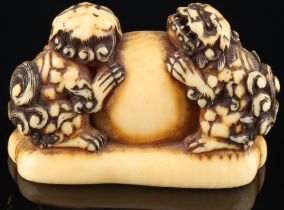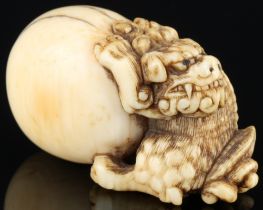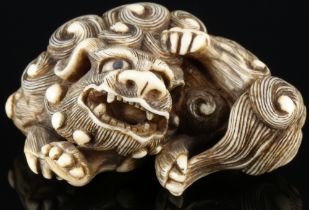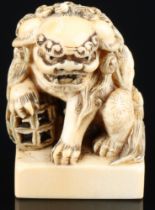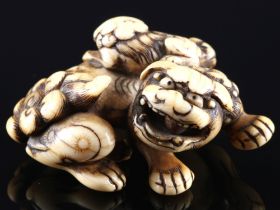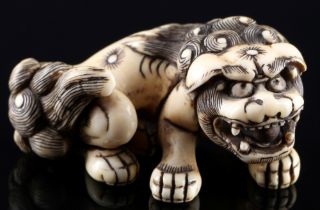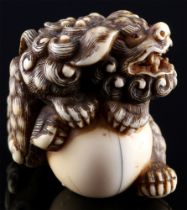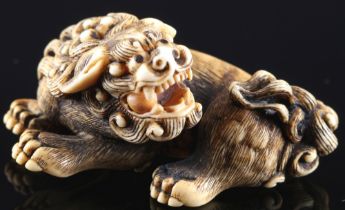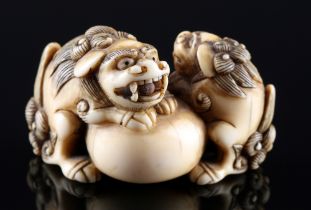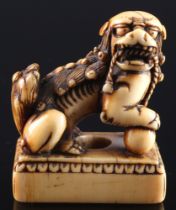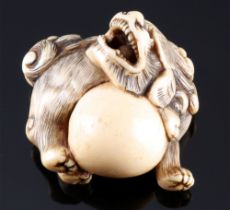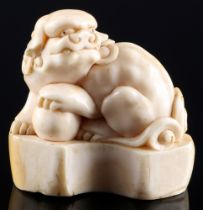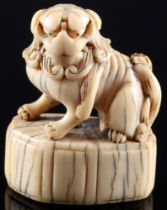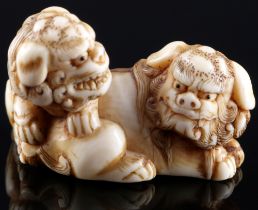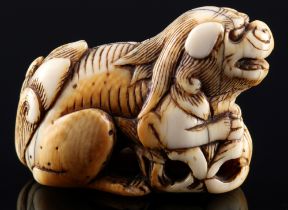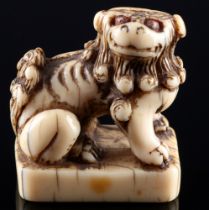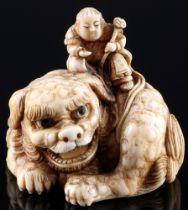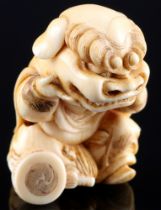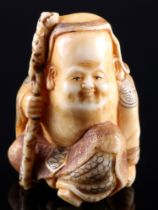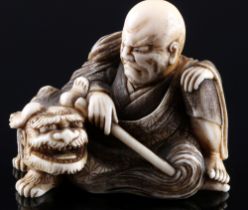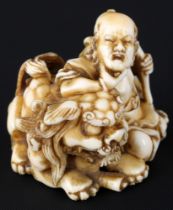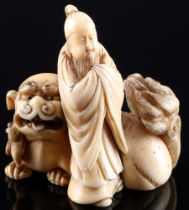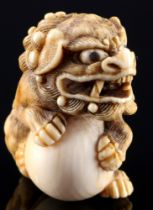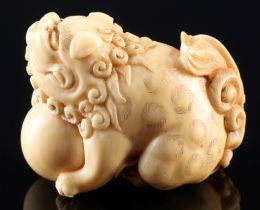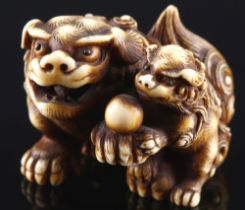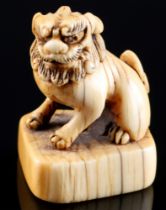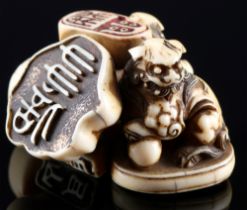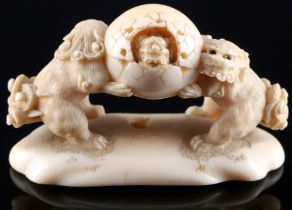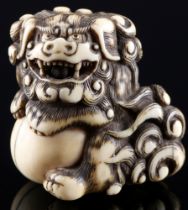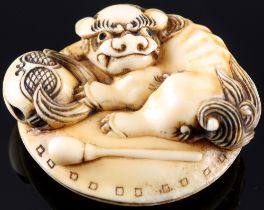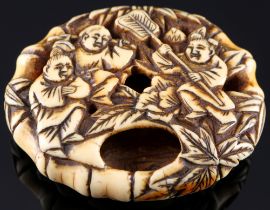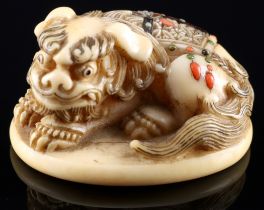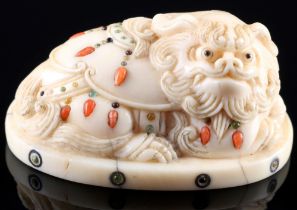Perfeziona la tua ricerca
Filtered by:
- Sale Section
- Elenco
- Grid
A subscription to the Price Guide is required to view results for auctions ten days or older. Click here for more information
Bronze incense burner, Japan, Meiji period 1868-1912, engraved three phoenixes, flowing clouds, floor mark Japan Kyoto, made by Yoschida, H 21.5 c...
Bronze, Japan Meiji period 1868-1912, large vase with birds and floral decoration partly in red, gold, black and green, above two embracing dragon...
Bronze / cloisonne, Meiji period 1868-1912, a total of 11 objects of which 4 colorful dragon cups, H 8 cm, 2 vases, H 19.5 cm, water bowl with Ruy...
Bronze, Japan, 2 large and heavy bronze guardian lions, 20th century, powerful and detailed shape, H 40 cm x L 43 cm x W 22 cm, weight 23.5 kg
Japan walking stick, early showa period,
Bamboo walking stick, Japan, Showa period 1926-1989, detailed carving of a giant python and monkeys, engraved on the bottom with a water moon swor...
Bone carved with steel blade, Japan, Meiji period 1868-1912, detailed carving with various character scenes, L 74 cm x W 3.5 cm, blade with rust, ...
Japan Edo period 1603 to 1868, ivory, the netsuke represents a shishi, leaning on a ball with its front paws, H 44 mm x W 42 mm x D 36 mm, weight ...
Japan Edo period 1603 to 1868, ivory, the netsuke represents a shishi, lying down, the head slightly raised, H 32 mm x W 53 mm x D 33 mm, weight 4...
Japan Edo period 1603 to 1868, ivory, the netsuke represents a pair of shishi, one lying shishi, the other standing and playing with its paw reste...
Japan Meiji period 1868 to 1912, hippopotamus, the netsuke represents a shishi quartet playing with balls. Expressive and very finely carved, pati...
Japan Edo period 1603 to 1868, ivory, the netsuke represents a shishi trio, two shishi playing, one shishi hiding under flowers and leaves. Finely...
Japan Edo period 1603 to 1868, ivory, the netsuke depicts a shishi with three animals, probably three dogs. Finely and expressively crafted, the p...
Japan Edo period 1603 to 1868, ivory, the netsuke represents a shishi with a young one, one lying down protecting the ball, the other lying on the...
Japan Edo period 1603 to 1868, ivory, the netsuke represents a shishi, lying down, the head slightly raised. Very expressively crafted, slightly p...
Japan Edo period 1603 to 1868, ivory, the netsuke represents a shishi, standing in a slightly crouched position, the mouth open menacingly. Very e...
Japan Edo period 1603 to 1868, hippopotamus, the netsuke represents a shishi couple playing together. Expressive and very finely carved, H 39 mm x...
Japan Edo period 1603 to 1868, ivory, the netsuke represents a shishi with a young one, the little one sits on the back of the big shishi, H 35 mm...
Japan Edo period 1603 to 1868, ivory, the netsuke depicts two shishi playing, a large shishi on the ball, a small shishi on the side trying to als...
Japan Meiji period 1868 to 1912, ivory, the netsuke depicts a shishi playing with a ball. The ball is decorated with fine patterns, painted with l...
Japan Edo period 1603 to 1868, ivory, the netsuke depicts a shishi with a young one, the little one lies on a base plate, protected from its mothe...
Japan, Meiji period 1868 to 1912, ivory, the netsuke represents a shishi caught in a ball, H 28 mm x W 42 mm x D 28 mm, weight 25.43 grams, Proven...
Japan Edo period 1603 to 1868, ivory, the netsuke represents a seated shishi, expressive on a base, H 42 mm x W 39 mm x D 16 mm, weight 19.96 gram...
Japan Edo period 1603 to 1868, ivory, the netsuke represents two playing shishi, both nestled against the ball, on a base plate, H 28 mm x W 44 mm...
Japan Edo period 1603 to 1868, ivory, the netsuke represents a shishi with a ball, looking grim and protecting the ball. The netsuke is signed, it...
Japan Meiji period 1868 to 1912, hippopotamus, the netsuke represents a shishi, lying on its stomach, scratching its left ear, H 22 mm x W 47 mm x...
Japan Edo period 1603 to 1868, ivory, the netsuke represents a shishi, sitting, the right paw placed over a brocade ball. Very expressively crafte...
Japan Edo period 1603 to 1868, ivory, the netsuke represents a shishi with a young one, a shishi lying with the ball in its mouth, the little one ...
Japan Edo period 1603 to 1868, ivory, the netsuke represents a shishi lying with a ball in its mouth. The pupils are inlaid with black horn, H 26 ...
Japan Edo period 1603 to 1868, hippopotamus, the netsuke represents a shishi, sitting with three paws holding a ball. The pupils are inlaid with b...
Japan Edo period 1603 to 1868, ivory, the netsuke depicts a shishi with two boys, a shishi lying with the ball in its mouth, the two little ones p...
Japan Edo period 1603 to 1868, ivory, the netsuke depicts a shishi, standing, in a proud position on a pedestal. Very expressively crafted, H 45 m...
Japan Edo period 1603 to 1868, ivory, the netsuke represents a shishi lying with a ball in its mouth. The pupils are inlaid with black horn, H 24 ...
Japan Edo period 1603 to 1868, ivory, the netsuke depicts two playing shishi, both leaning on a ball. A shishi has a ball in its mouth and its eye...
Japan Edo period 1603 to 1868, ivory, the netsuke represents a shishi sitting on a base with a rope in its mouth. The right paw rests on a small b...
Japan Edo period 1603 to 1868, ivory, the netsuke depicts a playing shishi, leaning protectively over a ball. The Shishi has a ball in its mouth, ...
Japan Edo period 1603 to 1868, ivory, the netsuke represents a shishi, the left paw rests on a small ball, sitting on a base. H 38 mm x W 39 mm x ...
Japan Edo period 1603 to 1868, ivory, the netsuke represents a shishi sitting on a base. Worked very expressively. You can see some dry cracks, H ...
Japan Edo period 1603 to 1868, ivory, the netsuke depicts two shishi playing. Expressively crafted, the eyes are inlaid with black horn, H 25 mm x...
Japan Edo period 1603 to 1868, ivory, the netsuke represents a shishi, both front paws placed on a flower. Expressively crafted, H 30 mm x W 42 mm...
Japan Edo period 1603 to 1868, ivory, the netsuke represents a shishi, sitting on a base, the head turned to the left side. Very expressively craf...
Japan Edo period 1603 to 1868, hippopotamus, the netsuke represents a shishi, with a man sitting on his back. He stretches out his hand like a beg...
Japan 19th/20th Century, ivory Katabori-Netsuke boy with shishi mask, signed, Meiji period,
Japan Meiji period 1868 to 1912, ivory, the netsuke depicts a boy with a shishi mask, expressively crafted, the signature cannot be clearly assign...
Japan Meiji period 1868 to 1912, hippopotamus, the netsuke represents a god of luck, Fukurokuju with stick. Sitting, resting contentedly within hi...
Japan Meiji period 1868 to 1912, hippopotamus, the netsuke represents a man with a shishi, sitting nestled together. The clothing is designed in d...
Japan 19th/20th Century, ivory Katabori-Netsuke man with shishi, Shungetsu, signed, Meiji period,
Japan Meiji period 1868 to 1912, ivory, the netsuke depicts a man with shishi, expressively crafted. The man has a stick in his hand and looks gri...
Japan Meiji period 1868 to 1912, ivory, the netsuke depicts a man with a shishi, expressively crafted. The man has a stick in his hand and looks g...
Japan Meiji period 1868 to 1912, ivory, the netsuke depicts a man with a shishi. The man standing with his back leaning against the shishi. Filigr...
Japan Edo period 1603 to 1868, ivory, the netsuke depicts a playing shishi, leaning protectively over a ball. The Shishi is expressively carved, t...
Japan Edo period 1603 to 1868, ivory, the netsuke represents a shishi, the right paw placed protectively on the ball. Very expressively crafted H ...
Japan Edo period 1603 to 1868, hippopotamus, the netsuke represents a shishi, sitting, scratching his left ear. The characteristic features are th...
Japan Edo period 1603 to 1868, ivory, the netsuke depicts a shishi with a young one, a sitting shishi with a ball in its mouth, a larger one on it...
Japan Edo period 1603 to 1868, ivory, the netsuke represents a shishi, sitting, mouth closed. Very expressively carved, H 36 mm x W 27 mm x D 29 m...
Japan Edo period 1603 to 1868, ivory, the netsuke represents two shishi, in the middle of several seals, H 25 mm x W 36 mm x D 34 mm, weight 18.19...
Japan Meiji period 1868 to 1912, ivory, the netsuke depicts three shishis, two playing with a ball in which a small shishi sits. The eyes are inla...
Japan Edo period 1603 to 1868, ivory, the netsuke depicts a playing shishi, leaning protectively over a ball. The shishi is expressively carved, t...
Japan Meiji period 1868 to 1912, ivory, the netsuke depicts a playing shishi, lying on a plate, with a temple bell and mallet. A brush is carved o...
Japan Edo period 1603 to 1868, ivory, the Ryusa-Manju Netsuke depicts a group of musicians around a shishi on the front. Also on the back are thre...
Japan Edo period 1603 to 1868, hippopotamus, the netsuke represents a standing senin, with a shishi on his shoulder. Very expressively carved, H 8...
Japan Meiji period 1868 to 1912, the netsuke represents a shishi lying on a base plate. A small blanket covers the shishi. This blanket has decora...
Japan Meiji period 1868 to 1912, ivory, the netsuke represents a shishi, lying on a base plate. A small blanket covers the shishi. Small stones ar...

